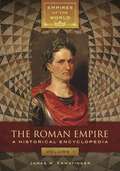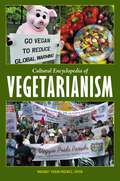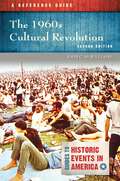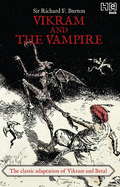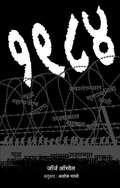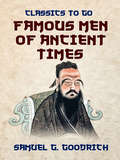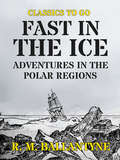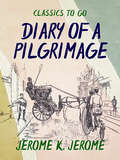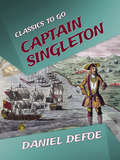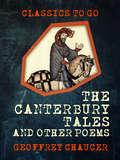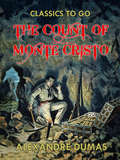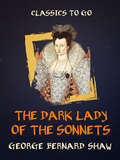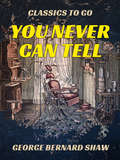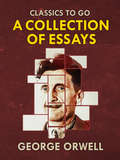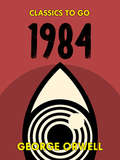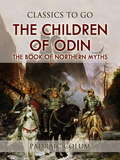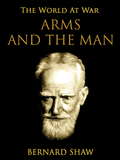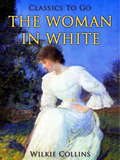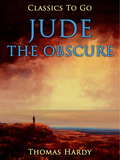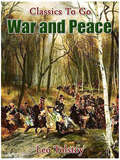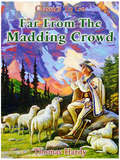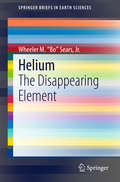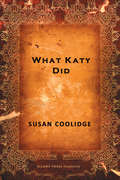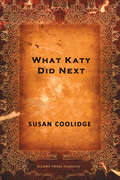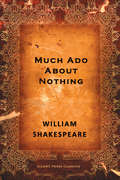- Table View
- List View
The Roman Empire [2 volumes]: A Historical Encyclopedia [2 volumes] (Empires of the World)
by James W. ErmatingerCovering material from the time of Julius Caesar to the sack of Rome, this topically arranged reference set provides substantive entries on people, cities, government, institutions, military developments, material culture, and other topics related to the Roman Empire.The Roman Empire was one of the greatest and most influential forces of the ancient world, and many of its achievements endure in one form or another to this day. Because of its geographic breadth, cultural diversity, and overall complexity, it is also one of the most difficult organizations to understand.This book focuses on the Roman Empire from the time of Julius Caesar to the sack of Rome. While most references on the Roman world provide a series of alphabetically arranged entries, this work is organized in broad topical chapters on government and politics, administration, individuals, groups and organizations, places, events, military developments, and objects and artifacts. Each section provides 20 to 30 substantive entries along with an overview essay. The work also provides a selection of primary source documents and closes with a bibliography of important print and electronic resources.
Cultural Encyclopedia of Vegetarianism
by Margaret Puskar-PasewiczIntended for students, general readers, vegetarians, and vegans, as well as those interested in animal welfare and liberation, this A–Z encyclopedia explores the historical and cultural significance of vegetarianism in the United States and beyond.Vegetarianism in the United States did not start in the 1960s—it has a much longer, complex history going back to the early 1800s. Cultural Encyclopedia of Vegetarianism examines that history through the lens of culture, focusing on what vegetarianism has had to say to and about Americans. This A–Z encyclopedia brings together the work of a number of scholars from diverse fields, including history, sociology, philosophy, religious studies, anthropology, nutrition, American studies, religious studies, women's and gender history, and the history of medicine. Approximately 100 essay entries cover cultural and historical aspects of vegetarianism, primarily but not exclusively in relation to the United States, shedding light on the practice's roots in ancient cultures and challenging popular myths and misconceptions related to both vegetarianism and veganism. With discussions on everything from activist movements to cookbooks, the encyclopedia offers a unique, wide-ranging exploration that will appeal to students, practitioners, and anyone else who wants to know more.
The 1960s Cultural Revolution: A Reference Guide (Guides to Historic Events in America)
by John C. McWilliamsThe 1960s Cultural Revolution is a highly readable and valuable resource revisiting personalities and events that sparked the cultural revolutions that have become synonymous with the 1960s.The 1960s Cultural Revolution: A Reference Guide is an engagingly written book that considers the forces that shaped the 1960s and made it the unique era that it was. An introductory historical overview provides context and puts the decade in perspective. With a focus on social and cultural history, subsequent chapters focus on the New Left, the antiwar movement, the counterculture, and 1968, a year that stands alone in American history.The book also includes a wealth of reference material, a comprehensive timeline of events, biographical profiles of key players, primary documents that enhance the significance of the social, political, and cultural climate, a glossary of key terms, and a carefully selected annotated bibliography of print and nonprint sources for further study.
Vikram And The vampire: Or, Tales Of Hindu Devilry
by Sir Richard F. Burton‘O King Vikram, listen to the true story which I am about to tell thee…’ Thus begins Vikram and the Vampire, British Orientalist Richard F. Burton’s classic retelling of the Sanskrit Vetala Panchavimshati (Twenty-five Tales of the Betal), the ever-popular tales about the legendary king Vikramaditya and the vampire, or Betal, who vexes the king with stories that pose searching questions about the morals of life in ancient India. Although based on earlier oral traditions, one of the stories’ first retelling is found in the eleventh-century Kathasaritsagara (Ocean of the Stream of Stories). Gods and demons, ghouls and kings, abound in these stories that capture mythic India at its best and bring to life an ancient world. An intrepid explorer and traveller, and an anthropologist with avid curiosity about far-flung cultures and peoples, Burton travelled to India in 1842, just as the first Afghan war came to an end. His interest in the region took him on journeys across the Indian subcontinent, often disguised as a Muslim man. An Indophile, he was at home with the Indian classics, and this retelling provided some of the first insights into these texts to Westerners. This new reissue of Burton’s adaptation of the classic tales, along with the 34 original black-and-white illustrations by Ernest Griset that accompanied the first edition, includes his original notes on the text and his introduction to the volume.
1984-George Orwell - Novel: १९८४-जॉर्ज ऑरवेलने - कादंबरी
by George Orwell‘१९८४’ हे पुस्तक अशाचपैकी एक आहे. जॉर्ज ऑरवेलने १९४८ साली हे पुस्तक लिहिले. भविष्यकाळातील सर्वंकष हुकूमशाहीचे चित्रण त्यात केले आहे. या पुस्तकाचा बोलबाला सर्व जगात जसा झाला, तसाच तो महाराष्ट्रातही झाला. ३६ सालात जगातील सुमारे ६२ भाषांत या पुस्तकाची भाषांतरे झाली. मराठीत मात्र मी या पुस्तकाचे केलेले भाषांतर प्रसिद्ध होण्यासाठी ३१ डिसेंबर १९८४ ही तारीख उजाडावी लागली. तेव्हा कुठे मराठी भाषा ही भाषांतराच्या यादीत ६३वी भाषा ठरली. त्या वेळी प्रकाशन समारंभाला श्री. ग. प्र. प्रधान (समाजवादी), श्री. ना. ग. गोरे (समाजवादी), श्री. प्रभाकर उर्ध्वरेषे (कम्युनिस्ट) इत्यादी राजकीय नेते उपस्थित होते. त्यांनी या पुस्तकाची मुक्त कंठाने स्तुती केली. १९८४ सालानंतर २७ वर्षांनी या पुस्तकाची दुसरी आवृत्ती बाजारात येत आहे. जॉर्ज ऑरवेलने म्हणतात की, आणीबाणीत अनेक प्रकाशकांना मी विचारले असता या पुस्तकाचे भाषांतर प्रसिद्ध करण्यास ते कचरले. त्यामागे भीती होती अन् ही भीती हीच हुकूमशहाची शक्ती असते. हुकूमशाही म्हणजे नेमके काय, हे ऑरवेलने यात दाखवले आहे. भीतीचा वापर केल्यावरही हुकूमशहाचे समाधान होत नाही. त्याला जनतेने स्वेच्छेने त्याच्यावर प्रेम करावे, त्याची भक्ती करावी असे वाटत असते. कोणतेही राजकीय तत्त्वज्ञान हा केवळ हुकूमशहा बनण्यासाठी घेतलेला आधार असतो. ‘खरी हुकूमशाही माणसाच्या रक्तातच असते काय?’ असा प्रश्न हे पुस्तक वाचल्यावर वाचकाला नक्की पडेल. तसेच हूकूमशाही अगदी टोकाला गेल्यावर काय काय घडू शकते, हे या पुस्तकात फार चांगले दर्शवले आहे.
Famous Men of Ancient Times: By The Author Of Peter Parley's Tales (Classics To Go)
by Samuel GoodrichExcerpt: "Confucius - From Famous Men of Ancient Times by S. G. Goodrich.... This greatest of Chinese philosophers was born in the petty kingdom of Lu, now the province of Shantung, in the year 549 B. C.-the same year that Cyrus became king of the Medes and Persians. The Chinese, in their embellishments of his history, tell us that his birth was attended with heavenly music, filling the air; that two dragons were seen winding over the roof; that five old men appeared at the door, and after consulting together, suddenly vanished; and that a unicorn brought to his mother a tablet in his mouth. It is also related that when he was born, five characters were seen on his breast, declaring him to be "the maker of a rule for settling the world." These and other marvels are a part of the established biography of the philosopher, as received by the Chinese...."
Fast in the Ice Adventures in the Polar Regions: Or Adventures In The Polar Regions (1870) (Classics To Go)
by R. M. BallantyneOne day, many years ago, a brig cast off from her moorings, and sailed from a British port for the Polar Seas. That brig never came back. Many a hearty cheer was given, many a kind wish was uttered, many a handkerchief was waved, and many a tearful eye gazed that day as the vessel left Old England, and steered her course into the unknown regions of the far north. (Goodreads)
Diary of a Pilgrimage (Classics To Go)
by Jerome K. JeromeDiary of a Pilgrimage is a novel by Jerome K. Jerome published in 1891. It tells of a trip undertaken by Jerome and his friend "B" to see the Oberammergau Passion Play in Germany. ( Wikipedia)
Captain Singleton: The Life, Adventures, And Piracies Of Captain Singleton (Classics To Go)
by Daniel DefoeThe book tells the story of Bob Singleton, who had been kidnapped as a boy from a good home and grew up with no real home. He came aboard a ship and eventually ended up being cast on an island with other crewmen. They managed to get to Africa and about the first half of the novel deals with the company's travel through Africa until they found a port from which they could get back to Europe. After their return there Singleton became member of another ships' crew and after a mutiny they led the lives of pirates with Singleton as their captain, which mostly covers the last half of the book, finishing in Singleton and a friend being repentant, leaving of their (successful) lives as pirates and returning home in disguise to find a peaceful life. (Excerpt from Goodreads)
The Canterbury Tales, and Other Poems: With Other Poems Of Chaucer And Spenser; Edited For Popular Perusal, With Current Illustrative And Explanatory Notes (classic Reprint) (Classics To Go)
by Geoffrey ChaucerThe Canterbury Tales is a collection of 24 stories written in Middle English by Geoffrey Chaucer between 1387 and 1400. In 1386, Chaucer became Controller of Customs and Justice of Peace and, in 1389, Clerk of the King's work. It was during these years that Chaucer began working on his most famous text, The Canterbury Tales. The tales (mostly written in verse, although some are in prose) are presented as part of a story-telling contest by a group of pilgrims as they travel together from London to Canterbury to visit the shrine of Saint Thomas Becket at Canterbury Cathedral. The prize for this contest is a free meal at the Tabard Inn at Southwark on their return. (Wikipedia)
The Count of Monte Cristo: In English Translation (Classics To Go)
by Alexandre DumasThe book is considered a literary classic today. According to Luc Sante, "The Count of Monte Cristo has become a fixture of Western civilisation's literature, as inescapable and immediately identifiable as Mickey Mouse, Noah's flood, and the story of Little Red Riding Hood. (Wikipedia)
The Dark Lady of the Sonnets: With Prefaces (Classics To Go)
by George ShawThe Dark Lady of the Sonnets is a 1910 short comedy by George Bernard Shaw in which William Shakespeare, intending to meet the "Dark Lady", accidentally encounters Queen Elizabeth I and attempts to persuade her to create a national theatre. The play was written as part of a campaign to create a "Shakespeare National Theatre" by 1916. (Excerpt from Wikipedia)
You Never Can Tell: A Pleasant Play (Classics To Go)
by George Bernard ShawYou Never Can Tell is an 1897 four-act play by George Bernard Shaw that debuted at the Royalty Theatre. It was published as part of a volume of Shaw's plays entitled Plays Pleasant. In June 2011, the play was revived at the Coliseum Theatre in Aberystwyth, Wales, where it had been performed exactly one century earlier. (Excerpt from Wikipedia)
Collections of George Orwell Essays (Classics To Go)
by George OrwellOne of the most thought-provoking and vivid essayists of the twentieth century, George Orwell fought the injustices of his time with singular vigour through pen and paper. In this selection of essays, he ranges from reflections on his boyhood schooling and the profession of writing to his views on the Spanish Civil War and British imperialism. The pieces collected here include the relatively unfamiliar and the more celebrated, making it an ideal compilation for both new and dedicated readers of Orwell's work. (Goodreads)
1984 (Classics To Go)
by George OrwellNineteen Eighty-Four, often published as 1984, is a dystopian novel published in 1949 by English author George Orwell. The novel is set in the year 1984 when most of the world population have become victims of perpetual war, omnipresent government surveillance and propaganda. (Wikipedia)
The Children of Odin The Book of Northern Myths: The Book Of Northern Myths (Classics To Go)
by Padraic ColumFrom master storyteller Padriac Colum, winner of a Newbery Honor for The Golden Fleece, comes a collection of fifteen timeless tales inspired by Norse mythology. (Amazon)
Arms and the Man (The World At War)
by Bernard Shaw“Arms and the Man” is a comedy by George Bernard Shaw, whose title comes from the opening words of Virgil's Aeneid, in Latin: Arma virumque cano ("Of arms and the man I sing"). (Excerpt from Wikipedia)
The Woman in White: A Novel (part Two) And Short Stories: The Dead Alive; The Fatal Cradle; Fatal Fortune; Blow Up With The Brig (Classics To Go #Vol. 1)
by Wilkie CollinsWilliam Wilkie Collins (8 January 1824 – 23 September 1889) was an English novelist, playwright, and author of short stories. His best-known works are “The Woman in White”, “The Moonstone”, “Armadale”, and “No Name”. “The Woman in White” is Wilkie Collins' fifth published novel, written in 1859. It is considered to be among the first mystery novels and is widely regarded as one of the first (and finest) in the genre of "sensation novels". The story is sometimes considered an early example of detective fiction with the hero, Walter Hartright, employing many of the sleuthing techniques of later private detectives. The use of multiple narrators draws on Collins's legal training, and as he points out in his Preamble: "the story here presented will be told by more than one pen, as the story of an offence against the laws is told in Court by more than one witness". In 2003, Robert McCrum writing for The Observer listed The Woman in White number 23 in "the top 100 greatest novels of all time", and the novel was listed at number 77 on the BBC's survey The Big Read. (Excerpt from Wikipedia)
Jude the Obscure
by Thomas HardyPowerful and controversial from its 1895 publication to the present, Jude the Obscure scandalized Victorian critics, who condemned it as decadent, indecent, and degenerate. Between its frank portrayals of sexuality and its indictments of marriage, religion, and England's class system, the novel offended a broad swath of readers. Its heated reception led the embittered author to renounce fiction, turning his considerable talents ever afterward to writing poetry.Hardy's last novel depicts a changing world, where a poor stonemason can aspire to a university education and a higher place in society--but where in reality such dreams remain unattainable. Thwarted at every turn, Jude Hawley abandons his hopes, is trapped into an unwise marriage, and pursues a doomed relationship with his free-spirited cousin, Sue Bridehead. The lovers find themselves equally incapable of living within the conventions of their era and of transcending its legal and moral strictures. Hailed by modern critics as a pioneering work of feminism and socialist thought, Hardy's tragic parable continues to resonate with readers.
War and Peace: A Historical Novel, Volume 1... (Classics To Go)
by Leo TolstoyThe standard Russian text of "War and Peace" is divided into four books (fifteen parts) and an epilogue in two parts. "War and Peace" has a large cast of characters, the majority of whom are introduced in the first book. Some are actual historical figures, such as Napoleon and Alexander I. While the scope of the novel is vast, it is centred around five aristocratic families. The plot and the interactions of the characters take place in the era surrounding the 1812 French invasion of Russia during the Napoleonic Wars. (Excerpt from Wikipedia)
Far from the Madding Crowd: Revised Edition Of Original Version (Classics To Go)
by Thomas HardyGabriel Oak is a young shepherd. With the savings of a frugal life, and a loan, he has leased and stocked a sheep-farm. He falls in love with a newcomer eight years his junior, Bathsheba Everdene, a proud beauty who arrives to live with her aunt, Mrs. Hurst. She comes to like him well enough, and even saves his life once, but when he makes her an unadorned offer of marriage, she refuses; she values her independence too much and him too little. Gabriel's blunt protestations only serve to drive her to haughtiness. After a few days, she moves to Weatherbury, a village some miles off. When next they meet, their circumstances have changed drastically. An inexperienced new sheep dog drives Gabriel's flock over a cliff, ruining him. After selling off everything of value, he manages to settle all his debts, but emerges penniless. He seeks employment at a work fair in the town of Casterbridge, (a fictionalised version of Dochester). When he finds none, he heads to another fair in Shottsford, a town about ten miles from Weatherbury. On the way, he happens upon a dangerous fire on a farm and leads the bystanders in putting it out. When the veiled owner comes to thank him, he asks if she needs a shepherd. She uncovers her face and reveals herself to be none other than Bathsheba. She has recently inherited the estate of her uncle and is now a wealthy woman. Though somewhat uncomfortable, she hires him. Meanwhile, Bathsheba has a new admirer: the lonely and repressed William Boldwood. Boldwood is a prosperous farmer of about forty whose ardour Bathsheba unwittingly awakens when – her curiosity piqued because he has never bestowed on her the customary admiring glance – she playfully sends him a valentine sealed with red wax on which she has embossed the words "Marry me". Boldwood, not realising the valentine was a jest, becomes obsessed with Bathsheba, and soon proposes marriage. Although she does not love him, she toys with the idea of accepting his offer; he is, after all, the most eligible bachelor in the district. However, she postpones giving him a definite answer. When Gabriel rebukes her for her thoughtlessness, she fires him. When her sheep begin dying from bloat, she discovers to her chagrin that Gabriel is the only man who knows how to cure them. Her pride delays the inevitable, but finally she is forced to beg him for help. Afterwards, she offers him back his job and their friendship is restored... (Excerpt from Wikipedia)
Helium: The Disappearing Element (SpringerBriefs in Earth Sciences #2)
by Wheeler M. "Bo" Sears, Jr.The subject of the book is helium, the element, and its use in myriad applications including MRI machines, particle accelerators, space telescopes, and of course balloons and blimps. It was at the birth of our Universe, or the Big Bang, where the majority of cosmic helium was created; and stellar helium production continues. Although helium is the second most abundant element in the Universe, it is actually quite rare here on Earth and only exists because of radioactive elements deep within the Earth. This book includes a detailed history of the discovery of helium, of the commercial industry built around it, how the helium we actually encounter is produced within the Earth, and the state of the helium industry today. The gas that most people associate with birthday party balloons is running out. “Who cares?” you might ask. Well, without helium, MRI machines could not function, rockets could not go into space, particle accelerators such as those used by CERN could not operate, fiber optic cables would not exist, and semiconductor chips could not be made…the list goes on and on.
What Katy Did
by Susan CoolidgeKaty Carr Book 1: Katy Carr's big dreams and desire for adventure are at odds with what is expected of her by her widowed father and the family's caregiver, Aunt Izzie. As a twelve-year-old girl, she is expected to help in the household and to set an example for her brothers and sisters, something that the mischievous Katy finds nearly impossible to do. But when her disobedience results in a terrible accident, Katy finds herself confined to her bed. Frustrated and at odds with her family, Katy must learn to make the best of things or risk driving her family away just when she needs them the most.
What Katy Did Next
by Susan CoolidgeKaty Carr Book 3: The irrepressible Katy Carr returns in the third novel in Susan Coolidge's charming series. Presented with the chance to travel abroad as the companion to her dear friend, Amy, Katy is initially reluctant to accept the invitation, but is soon persuaded to change her mind. Over the course of the tour, Katy experiences the culture of Europe and finds herself falling in love most unexpectedly.
Much Ado About Nothing
by William ShakespeareTwo couples—Benedick and Beatrice, and Hero and Claudio—must overcome deception, gossip, and, occasionally, their own misplaced pride if their love is to persevere.
